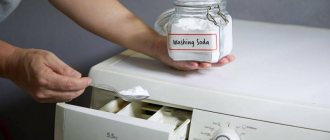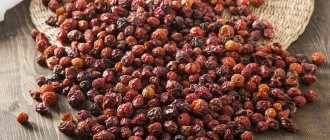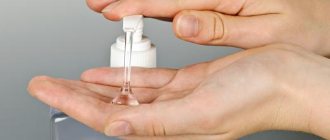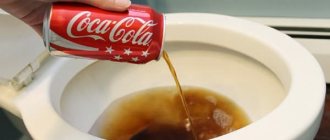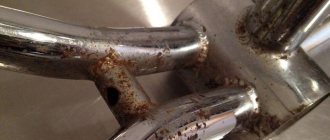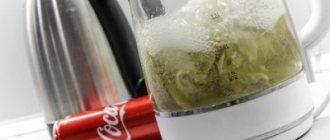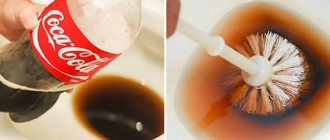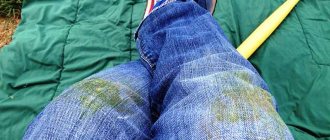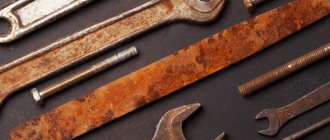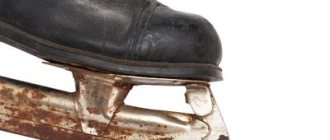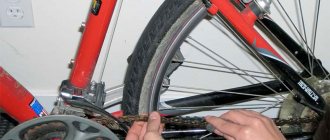Metal corrosion not only spoils the appearance of things, but also reduces their service life. In some cases, you can even deal with rust at home using improvised means.
One easy way is to use Coca-Cola. But this cleaning option has some features that are best known in advance.
We will tell you in the article whether this drink removes rust marks and how to use Coca-Cola in the fight against rust.
Coca Cola
There are a lot of ways to remove rust using Coca Cola on the Internet, let’s check it out. We took the most ordinary bottle, which is sold in any supermarket.
For example, in this video, we can see how Coca Cola perfectly removes rust from an old car bumper.
We'll just soak a cloth in Coca-Cola and leave it for a while. In our case, unfortunately, Coca-Cola did not help significantly remove the rust, despite the fact that the overall yellowness of the area decreased, the areas of corrosion did not change at all. The area after treatment with Coca-Cola looks just as terrible as before.
Nevertheless, Coca Cola can be used to clean surface rust well, since it contains phosphoric acid. But it’s better to use a rust converter directly with this acid.
The ideal way to remove rust with Coca-Cola is to put the rusty items in it and leave it for at least 24 hours. Look how we used this method to remove rust from old wheel bolts.
The components of the “classic” version of Coca-Cola are:
purified carbonated water; sugar; natural caramel coloring; acidity regulator orthophosphoric acid; natural flavors; caffeine.
Features of the effect of the drink
If the metal is not protected by a coating, rust may form on it as a result of interaction with the external environment (oxygen and moisture). Over time, corrosion eats away at the material more and more, and it becomes brittle.
The effectiveness of Coca-Cola against rust marks is explained by the inclusion of orthophosphoric acid in its composition . This is a food additive approved for use in the food industry. According to the international classification, it is coded “E338”.
In addition to food products, phosphoric acid is also used in special products - rust converters.
Due to its chemical properties, this substance, interacting with damaged metal, converts iron hydroxide into iron phosphate. As a result, corrosion stops completely.
In what cases will the cleaning method be effective?
The method of using drinks containing orthophosphoric acid gives good results with minor rust lesions.
It is convenient to clean small consumable parts with cola, for example:
- screws;
- nuts;
- screws, etc.
When won't it help?
Despite the inclusion of orthophosphoric acid in the composition, the use of cola may not always be highly effective .
Situations where it is recommended to use a commercial rust converter and a stiff brush are when there is significant corrosion.
It can also be difficult to treat large areas affected by rust.
Coca-Cola will not help in cases where it should be removed:
- greasy and oily contaminants;
- paints;
- ink, etc.
Acetic acid (70%)
There are many options for acetic acid, 10 - 15 - 20%, but it is better to take the most powerful, more than 70%, this acid is called glacial.
We fill the bumper with rust and leave it for the same 45 minutes. Vinegar undoubtedly eats away rust; you can see from the yellow coating on top that the rust is decomposing, but apparently this time is simply not enough.
To remove rust with vinegar, it is recommended to completely immerse the rusty part in vinegar for 24 hours. Unfortunately, this method is not very suitable for us to remove rust from a car.
Advantages and disadvantages of the technique
The Coca-Cola cleaning method has many advantages:
- The product is always on sale.
- Cleaning small items is very easy.
The disadvantages include the following:
- Weak effectiveness with extensive metal damage and a thick layer of rust.
- If you need to clean a large number of items, you will need a lot of cola.
- Cleaning bulky items with cola is inconvenient and time-consuming, or you will need a large volume of the drink, which may not be financially viable.
- Not suitable for processing complex mechanisms.
- Coca-Cola is not an all-purpose cleaner, so it won't work on many types of stains.
What can replace this soda?
In the recipe for cleaning products from rust, Coca-Cola most often appears as one of the popular drinks that everyone hears thanks to a wide advertising campaign.
But this does not mean that using other sweet carbonated drinks will not give results in cleaning things from rust.
You can replace Coca-Cola with any soda that contains citric acid, even regular lemonade. The effect of such processing of things will also be, but a little weaker, since cola contains phosphoric acid.
Why is cola used for cleaning?
Some people, seeing how the drink removes rust, refuse to buy it. They say it’s all chemicals, from which you can easily get a stomach ulcer. Fears, of course, are greatly exaggerated. If you drink Pepsi or Coke in limited quantities, and not 1-2 liters every day, there will be no more harm from such a drink than from any other soda.
But then a logical question arises: what about its cleaning properties? The answer is simple: cola is the most advertised drink among sodas. Any lemonade has similar qualities, because it contains citric acid. Many housewives know how this product easily cleans grease and other stains.
The effect of using cola may be slightly greater than others due to the phosphoric acid content. It minimizes the risk of re-occurrence of corrosion on metal surfaces by forming a protective film on them. But there is not much difference between them.
Automobile
With the same success, Pepsi will come to the aid of motorists. If the glass cleaner doesn't do the job, you can take the glass cleaner and gently apply it to the stains. After some time, the plaque will begin to dissolve. Then remove any remaining soda from the glass with a dry cloth.
In exactly the same way, cola is used to remove corrosion on the bumper and battery. Just use a hard sponge instead of a napkin.
Lemon juice
If you won't remove a rusty part, such as a screw or nut, one of the easiest ways to remove the rust is to use salt and lemons. Take salt and sprinkle it on the rusty area. Then squeeze lemon or lime juice over the salty, rusty stain. Next, leave it for several hours.
Next, use steel wool or any other textured cloth to remove the rust. You can also use lemon zest to remove rust without harming the metal.
Does cola clean silver?
Silver items require cleaning from time to time. Cup holders and spoons, figurines and even decorative inserts in furniture sets become covered with dust, green deposits, and rust. Coca-Cola perfectly cleans silver, and when heated, it can remove any old stains.
For cleaning you will need ½ liter of soda and a deep metal container. To restore the shine and purity of silver products, you need to do the following work:
- pour cola into a container;
- put items that require cleaning there;
- place on a gas or electric stove;
- bring the liquid to a boil;
- boil for 5 minutes;
- remove the products and wait until they cool down;
- rinse in clean water;
- wipe dry with cotton cloth.
This is how you can easily and inexpensively remove any stains from silver items.
Bathroom
When cleaning the toilet, you need to pour 1-2 liters of cola into the bowl so that the liquid covers all the limescale. Leave overnight. Then use a toilet brush to wash the most problematic areas, and then flush the water. Cola is convenient because it helps remove not only stains, but also persistent unpleasant odors.
When treating a bathtub or sink, just wipe it with a cloth soaked generously in soda, leave it for a while and rinse with water.
A drink with an expiration date will not work. Only fresh cola eats away rust quickly and efficiently.
In what cases is there no result?
After seeing how cola and rust interact with each other, housewives may be inspired to try using it to remove other stains. But it was not there. In some cases, this drink is of no use.
The cola can be safely put aside when removing:
- fat and oil - your usual detergent will help here;
- paint or ink - alcohol and specially developed preparations can better cope with this problem.
Also, cola will be useless against bacteria and germs. You can get rid of them only with the help of disinfectants.
How it works?
Many people are interested in the question of what is contained in cola that allows it to effectively deal with rust and limescale. The fact is that the drink contains a large amount of phosphoric and citric acids. Due to the huge amount of sugar, the sour taste is almost unnoticeable, but the level of acidity of soda is comparable to 3% vinegar essence, which is so often used as a cleanser.
A solution of citric, acetic or malic acid will clean a contaminated surface no worse than Coca-Cola, because the pH of these liquids is the same. But it’s expensive to clean plumbing fixtures or clothes with natural apple or lemon juice, and vinegar essence smells unpleasant. Perhaps the only worthy alternative to cola is citric acid, which is inexpensive and has no specific odor.
What prompted me to use Coca-Cola to remove rust from nuts
I heard from friends and read in various publications that Coca-Cola has “magical” properties for cleaning rusty surfaces. But these were only some superficial ideas. And then I paid attention to the wheels of my car and saw that the nuts began to rust.
Of the four nuts on the wheel, three are normal. Because they are original from the factory. And one of them, a secret one, which I bought on the market and installed instead of the original ones, began to rust. Of course, I didn’t bring the nuts to a completely ugly state, however, the wheels didn’t look very good with such nuts. And given the new black polished wheels, a rusty nut on each wheel was immediately noticeable and spoiled the entire appearance of the wheels and the car.
You can take a look for yourself at the photo below.
My car wheels with rusty lug nuts
In the photograph, the rust on the nuts is not very noticeable, but in real life they looked much more contrasting compared to the original nuts (especially on clean and shiny wheels).
And so, having decided to return the nuts to their former freshness and shine, I began to study the issue of cleaning them from rust. I read the Internet and asked friends.
And then one of my friends said: “Just throw them in Coca-Cola, the rust will go away on its own!”
I have heard about the “miraculous” properties of overseas carbonated drinks before. But all this was at the level of rumors.
Someone said that in Samara, at the Pepsi and Coca-Cola production plants, all the pipes are replaced almost every three to four months, since soda corrodes them to holes.
I read somewhere that Coca-Cola and Pepsi completely dissolve meat and sausage immersed in them. But these were all rumors and unverified information.
But after weighing all the pros and cons, I figured it out and decided that what the hell is not joking. Let me try, I think. And at the same time I’ll tell you about the experiment on my blog.
This is how my next life hack was born, or rather, testing it in practice.
Descaling
The formula that creates this soda, adored by millions of people around the world, is unknown to anyone. Perhaps this is for the better, because thanks to this riddle you can easily descale the kettle. To do this you need:
- Pour a little more than half of the volume into the kettle.
- Bring it to a boil and leave to cool inside the device so that it reacts with internal deposits.
- When it cools down a little, you can use sponges and brushes to speed up the process. For hard-to-reach places, you can use a toothbrush.
- If necessary, the procedure can be repeated. It is acceptable to leave the soda in the kettle overnight.
- After the scale has completely disappeared, the kettle should be thoroughly rinsed with clean water.
Recommendations
In order for rust removal with Coca-Cola to go well, you need to familiarize yourself with the advice of experts:
- If cleaning does not remove all the rust the first time, the action can be repeated.
- Objects soaked in Coca-Cola should not be stirred, removed or exposed to other influences during cleaning.
- Cola does not have disinfectant properties, so if, for example, mold is detected, it is worth using special targeted products.
- You cannot use cola to clean complex devices with built-in electronic components and other elements that are prohibited from being exposed to liquids.
- In addition to rust, cola is also effective in combating limescale, for example, on plumbing fixtures.
